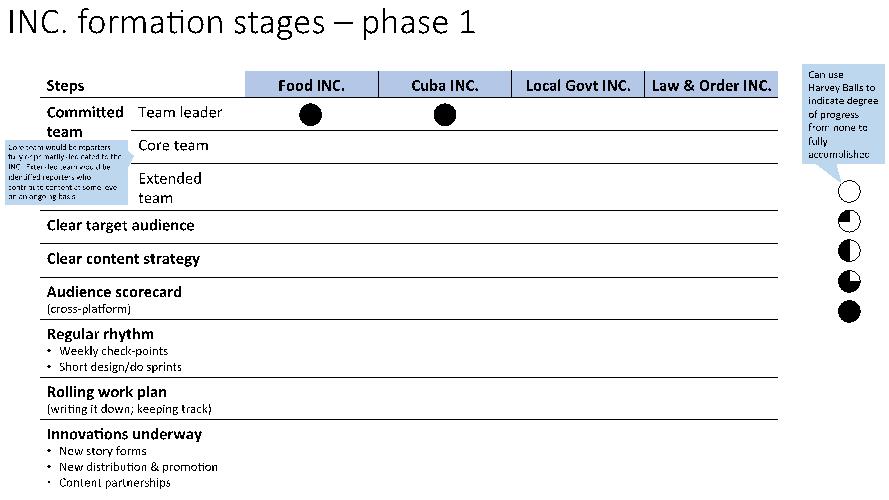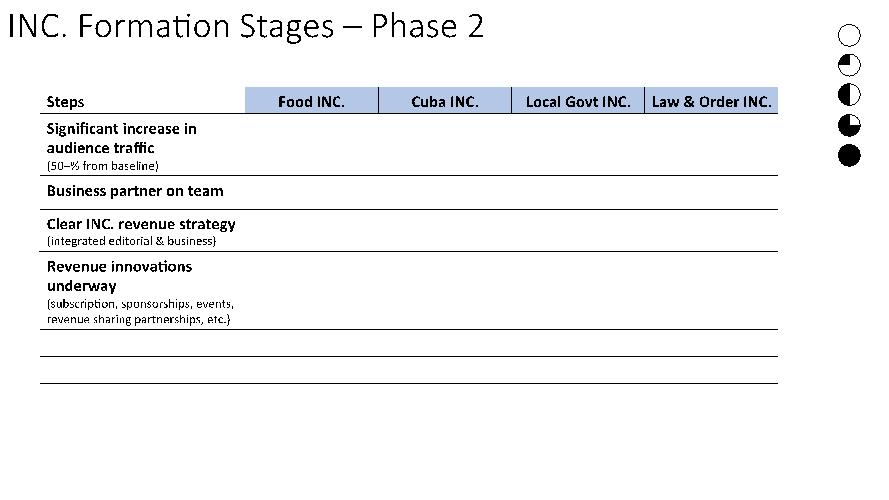Mini-publisher perspective: Assessing the gaps in your newsroom
Douglas K. Smith, Quentin Hope, Tim Griggs, Knight-Lenfest Newsroom Initiative,This is an excerpt from “Table Stakes: A Manual for Getting in the Game of News,” published Nov. 14, 2017. Read more excerpts here.
Gap: Shortfalls in general management skills, disciplines and accountability
Ask folks to use this assessment — then meet together to compare answers on individual items and overall scores.
| Yes | No | |
| 1. If asked, most folks across our enterprise would say we offer two main products to our audiences: print and digital. | ||
| 2. While our newsroom is more aware of audiences today than before, we rarely collaborate across our entire enterprise about which specific audience segments we can serve well. | ||
| 3. We do not have general managers who oversee audiences or platforms as businesses. | ||
| 4. We have a clear separation between editorial/content and business – and very few positions span both sides. | ||
| 5. We operate largely/mostly within siloes – for example, desks keep pretty much to themselves as do sales, marketing and other departments. | ||
| 6. While we have some good examples of collaboration among individuals, we do not routinely use teams with a shared set of goals to which they hold themselves mutually accountable. | ||
| 7. Who is responsible for what products, services or businesses is not clear –other than the publisher being responsible for all of what we do. | ||
| 8. Our enterprise essentially operates under a single P&L for which the publisher is responsible. | ||
| 9. We do not match revenues to expenses for specific audiences or platforms – or, if we do, I am not aware of that. | ||
| 10. We have few folks with real experiences as general managers who have responsibility for ensuring revenues exceed expenses – possibly only the publisher. | ||
| 11. We have few folks with strong, deep experiences as product or project managers. | ||
| 12. Most people in our enterprise work as individuals reporting to bosses as opposed to teams with shared goals and mutual accountability. | ||
| 13. Our senior newsroom leaders focus most of their time and attention on the daily to weekly challenges of ensuring the best print and digital content. | ||
| 14. Financial budget discussions in our newsroom focus only on expenses; revenues are not part of what is discussed or, if discussed, only cursorily. | ||
| 15. Few, if any, of our newsroom leaders have ever put together a business proposal or plan that includes projections for revenue, expense and profitability. | ||
| Total: |
Gap: Current versus optimal mini-publisher approach
The mini-publisher concept for key audiences and platforms is an end game toward which to evolve. The following spectrum provides markers along a continuum. Note that it is cumulative – that is, each stage builds on the prior ones.
You and your colleagues should use the spectrum to identify where things stand today versus the end game of fully operational and accountable mini-publisher audience and platform leaders and teams.
Spectrum of development of mini-publisher audience and platform teams
| AUDIENCE-based mini-publisher teams | ||||
| Current newsroom | Starting audience team | Well-developed audience team | Audience-based mini-publisher team | |
| Organization unit/staff | – Conventional beat, desk or vertical structure | – Core newsroom team with audience-first focus supported by platform and other newsroom specialists | – Core team as described with working relationships with business-side | – Cross-functional core team with full P&L responsibility for target audience |
| Charter, Work,
Accountability |
– Story focused
– Cover institutions, organizations related to beats – Deliver on assignments |
– Audience-first focus
– Have defined target audiences – Serve targeted content to targeted audience – Accountable for audience growth and engagement across platforms
|
– Convert/funnel occasional users into habitual, monetized loyalists
– Wide distribution in concert with platform specialists – Content partnership development – Audience revenue experiments |
– Audience growth (all dimensions)
– Revenue growth – Cost management, including average content cost through blending hi and lower cost approaches (e.g. aggregation) – Net financial contribution (attributable revenue – expenses) |
| Success metrics | – Meeting deadlines
– Some overall traffic numbers |
– Traffic, local vs non-local uniques by platform
– Reporter- and story-level traffic performance |
– Local audience engagement and loyalty measures
– Attributable revenues from funneling |
– P&L performance
– Performance of partnerships
|
| Knowledge, skills and tools
|
– Beat reporting editing | – Understanding audience needs and interest
– Audience focused story telling – Audience engagement skills – Access to basic data and analytics |
– Understanding of specific problems being solved for audiences
– Story form and platform experimentation and learning – Content partnership development – Customized data and analytics |
– Partnership development and management
– ROI thinking; contribution management – Project management |
| Key relationships | – Other folks on the desk and/or in the vertical
– Sources within institutions, organizations being covered |
– Platform, audience, social and other specialists
– Tech/tool providers |
– Platform teams
– Business side colleagues – External partners |
– Senior enterprise leaders
|
Note: all dimensions are cumulative; each level builds on the foundation of the prior level
| PLATFORM-based mini-publisher teams | ||||
| Current newsroom | Starting platform owner | Well-developed platform owner | Platform cluster
Mini-publisher team |
|
| Organization unit/staff | – Audience developers in a separate, specialist unit | – Individual platform owners | – Platform ownership group that divvies up platforms, holds each other accountable and coordinates with key folks from audience teams as well as business side | – Cross-functional platform teams responsible for P&L of clusters/groups of platforms |
| Charter, Work and Accountability | – Day-to-day platform posting and upkeep
– Spend most of their time ‘doing things for’ others instead of with them in ways that grow skills across the newsroom – Expected to keep up with platform developments and share tips |
– Platform audience growth (local market)
– Platform skill building through shift in time from mostly ‘do it for’ others to ‘do it with them’ plus training – Expected to communicate implications of platform developments to how newsroom must do work |
– Platform-driven audience growth and engagement
– Funnel audiences from random users to habitual, monetized loyalists – Speed of adoption and implementation of platform developments – Taps widespread platform skills in the newsroom |
– Audience growth and engagement for platform clusters
– Conversion rates through funnel plus revenue – Platform revenue growth – Platform P&L and financial contribution to enterprise – Platform innovation |
| Success metrics | – Traffic on platform | – Overall platform traffic performance, with particular attention to local audiences
– Speed and effectiveness of adjustments required by shifting platform landscape |
– Platform loyalty and engagement measures
– Conversion rates through the funnel – Performance against competitor benchmarks – Demonstrated platform skills in newsroom |
– Platform audience measures
– Local market platform rank/share – P&L and financial contribution – Number and quality of innovations – Platform-driven successes of audience teams |
| Knowledge, skills and tools | – How-to’s of using the platform
– Various best practices – Rudimentary data and analytics |
– Core understanding of keys to success on the platform
– Training and coaching others in the effective use of the platform – More customized and actionable platform data and analytics |
– Deep understanding of platform dynamics and audience behaviors
– Advanced platform data and analytics |
– Understanding of revenue flows and opportunities within and across related platforms
– Partnership development and management with external platform owners |
| Key Relationships | – Desks
– Senior newsroom leaders – Industry colleagues |
– Audience teams
– Tech and tool builders – Key vendors |
– Business side leaders
|
– Senior enterprise leaders
|
Note: all dimensions are cumulative; each level builds on the foundation of the prior level
Here is how Miami, for example, tailored a picture to assess their migration toward audience-based mini-publisher teams:

